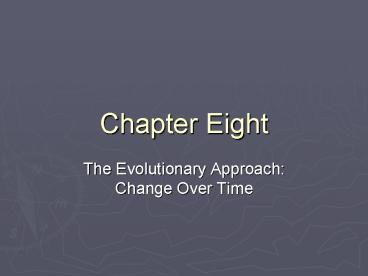Chapter Eight - PowerPoint PPT Presentation
Title:
Chapter Eight
Description:
Chapter Eight The Evolutionary Approach: Change Over Time – PowerPoint PPT presentation
Number of Views:106
Avg rating:3.0/5.0
Title: Chapter Eight
1
Chapter Eight
- The Evolutionary Approach Change Over Time
2
Evolutionary Psychology
- Evolutionary Psychology (EP) describes how our
early environment produced our current mental
abilities. - This environment was the the Pleistocene era,
approximately two million years ago, referred to
as the Environment of Evolutionary Adaptation
(EEA). - Evidence to support evolutionary hypotheses comes
from archeological records, hunter-gatherer
societies, between- and within-species
comparisons, and experimentation.
3
Natural selection
- EP relies on Darwins (1859) theory of natural
selection. It requires three elements - Variation in traits within a species.
- The passing of genetic material from one
generation to the next, called inheritance. - Selection, which is a change in the environment
that favors one trait over another.
4
Evolved psychological mechanisms
- EP views the mind as a collection of special
purpose devices or a Swiss army knife. - Each device evolved under selection pressures to
solve a specific problem. - These mechanisms can be considered as modules.
- This is in contrast to the traditional notion of
mind as a general purpose processor.
5
Properties of an evolved psychological mechanism
- Solves a specific adaptive problem.
- Takes in only a narrow band of information.
- Informs the user of the type of problem.
- Produces a response through a set of decision
rules. - The response can be a physiological reaction,
information to another mechanism, or a behavior. - The response is intended to provide a solution to
the problem.
6
Evolution and categorization
- We form concepts in a graded, continuous fashion,
not all or none. - Natural categories are also continuous. The mind
mimics this organization. - This allows us to generalize our knowledge from
one category to another. - Concepts are organized around representative
members of a class, the typicality effect.
7
Which looks more like a bird?
8
Evolution and memory
- We should have a better memory for information we
are exposed to more often. - This is because it is more relevant to our
survival. - Recall for words is proportional to their
frequency of occurrence (Anderson and Schooler,
1991).
9
The Wason selection task - hard version
- You have been hired as a clerk. Your job is to
make sure that a set of documents is marked
correctly, according to the following rule "If
the document has an E rating, then it must be
marked code 4." You have been told that there are
some errors in the coding of the documents, and
that you need to find the errors. Each document
has a letter rating on one side and a numerical
code on the other. Here are four documents. Which
document(s) do you need to turn over to check for
errors?
10
The Wason selection task - easy version
- You have been hired as a bouncer in a bar and you
must enforce the following rule "If a person is
drinking vodka, then he must be over twenty years
old." The cards above have information about four
people in the bar. One side of each card lists a
person's age and the other side shows what he or
she is drinking. Which card(s) do you need to
turn over to be sure no one is breaking the law?
11
Evolution and logical reasoning
- The bouncer problem is easy because it involves
cheater-detection. - In the EEA it was important to detect who might
be cheating because in small groups with limited
resources it might mean less for you (Cosmides
and Tooby, 1992). - The logic module thus works only in this context,
implying logic is not domain general.
12
Evolution and judgment under uncertainty
- Uncertain judgments occur when we make a decision
without complete information. - Most everyday decisions in life are like this.
- In such cases, we often rely on heuristics.
- But heuristics can lead us to commit fallacies, a
misunderstanding of statistical rules.
13
Fallacies
- Base-rate fallacy. Ignoring base rates.
- Conjunction fallacy. Ignoring the conjunction
rule. - Gamblers fallacy. Ignoring independent outcomes.
14
Evolution and language
- Language may have evolved to promote social
bonding (Dunbar, 1996). - It allows for complex coordinated social
behavior. Examples improvements in hunting,
foraging, and childcare. - It may also play a role in sexual selection.
15
Evolution and sex differences
- Attributed to a sexual division of labor in which
men hunted and women gathered. - Hunting may have fostered increased spatial
ability in men. - Gathering may have promoted increased verbal
abilities in women. - But above distinction is too broad. Women are
better at object location memory.
16
Evolutionary Computing
- Thinking may utilize evolutionary principles.
- Steps in problem solving
- Generate candidate solutions.
- Evaluate their fitness.
- Select solutions with high fitness values.
- Generate new solution offspring by genetic
combination. - Repeat steps 2-4.
17
Artificial Life
- The study of manmade systems that behave in ways
characteristic of natural living systems
(Langton, 1989). - Computer creatures are created through
evolutionary rules. They navigate, seek out prey,
and avoid predators in a virtual environment. - Complex adaptive behaviors emerge including
parasitism, symbiosis, and flocking.
18
Neural Darwinism
- Application of evolution to neural learning
(Edelman, 1989). - Initial growth of neural structures during
development. - Interaction with environment causes differential
modification of synaptic strengths. - Reentrant signaling between neural groups.
19
Evaluating the evolutionary approach
- Novel biological function need not arise to
service survival or reproduction. Other
mechanisms - Exaptation or neutral drift. Random mutation.
- Molecular drive. Copies of genes mutate.
- Idea of a spandrel (Gould, 2000). Byproducts of
adaptations.
20
Spandrels in architecture































